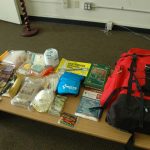Swimming in natural waters is very unlike swimming in pools and visitors must be aware of the safety precautions to take before taking a trip. These places are the least likely to have first-responders available and might be pretty far from the nearest hospital or for an ambulance to drive. If you are taking children, safety must take priority and distraction is non-tolerated by mother nature. Take these points seriously and enjoy your visit to a beautiful natural swimming scene.
Ocean
Oceans are beautiful, but can become dangerous quickly. Potential hazards include sand holes, high tides, swift currents, cold water, and fast moving debris. It’s wise to check the forecast before going to the beach. The forecast should make you aware of any ‘high tide advisory’. If you don’t do this beforehand, you can evaluate the tide from the beach. Double the biggest wave to know how big they might get during your visit. Always keep an eye on the ocean to detect oncoming waves. Keep your eyes on children at all times. It only takes a moment to get into serious trouble with the ocean.
Wear flotation equipment when in a boat, on a jet ski, or just going in the ocean if it makes you feel more comfortable. Cold water can quickly steal your strength, so be aware of this vulnerability as well. If you are caught in a tide you feel out of control in, swim toward the beach parallel to the wave until you’re able to switch directions toward the safety of the beach. It’s best not to attempt to save someone who has been caught in the tide. Wave down help from a designated beach rescue tower or building.
Lakes
The most alarming dangers of swimming in lakes is not knowing the depth of where you are swimming, thunderstorms, and being far away from professional help or assistance if something were to happen. The first things you need to commit to when being as safe as possible at the lake is being trained in CPR because you might have to be the first-responder. To prevent an emergency from happening, avoid drinking alcohol while at the beach and do not play games, talk on the phone, or do anything that will distract you from watching children while at the beach. Even if your children have been taught to swim, drowning can make people panic and forget what they’ve learned. Never use pool noodles, floaties, or other floatation devices instead of life jackets. These items are not meant to prevent drowning and cannot be relied on for safety purposes. Always wear them when boating.
Rivers, Streams, and Waterfalls
These bodies of water are some of the most dangerous because they are always moving and their currents can be very strong. Like lakes, determining the depth of these waters is unpredictable so never dive or jump from cliffs. If you are trying to cross or swim in these bodies of water, unbuckle your pack if you are wearing one because the weight can pull you under if the water takes you. There are packs that have the ability to become floatation devices. Investing in this is wise. Otherwise, you can wear a life jacket at all times. If the water takes you, do not attempt to stand. Standing in water is one of the surest ways to be taken under water. Instead, lie on your back with your legs and feet pointed down stream. Stick your toes toward the sky and prepare to beat off jagged rocks on the way down to safety in a less rapid area of water. Most drownings occur with elements of panic, trying to stand, and then getting your legs stuck between rocks, fallen trees, or other debris. It’s best to observe these waters from designated trails and areas where signage approves viewing.



